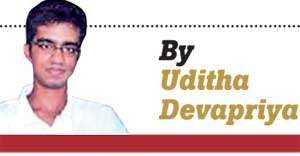15 Feb 2019 - {{hitsCtrl.values.hits}}
Being a short note on why I am not a Ceylonese/Sri Lankan nationalist
 epending on how you see it, Sri Lanka is either a nation of many cultures or a culture of many nations: Sinhala, Tamil, Muslim, Burgher and so forth. It is up to us to construct an identity transcending petty labels and it is up to us to ensure that such an identity, once constructed, is adhered to and privileged at all times. The simple truth is that no one outside cares as to whether what we produce, and give back to the world, is made by a Sinhalese Buddhist male heterosexual in his mid-forties. When it goes there, the product becomes distinctly Sri Lankan. 71 years after independence, we seem to have failed to grasp this fundamental reality. We never learn.
epending on how you see it, Sri Lanka is either a nation of many cultures or a culture of many nations: Sinhala, Tamil, Muslim, Burgher and so forth. It is up to us to construct an identity transcending petty labels and it is up to us to ensure that such an identity, once constructed, is adhered to and privileged at all times. The simple truth is that no one outside cares as to whether what we produce, and give back to the world, is made by a Sinhalese Buddhist male heterosexual in his mid-forties. When it goes there, the product becomes distinctly Sri Lankan. 71 years after independence, we seem to have failed to grasp this fundamental reality. We never learn.
On the other hand, that this is somehow a licence to cast aside and forget the ethnic dimensions of grief and grievance, of victory and loss, is taking the argument that we are all one nation too far. Historically, there has never been a Sri Lankan identity, just as there has never been a Ceylonese identity. It is a fairly recent cultural construct, and it depends, for its perpetuation, a vaguely defined, amorphous, and fragile framing of citizenship. It is premised on ethnic and religious labels; for this reason, it never truly transcends those labels. Once again, 71 years after independence, we seem to have failed to understand this fundamental reality. 
By 1948, identity politics in Sri Lanka had become so vaguely defined that there were two broad nationalisms: a Sinhala Buddhist nationalism and a Ceylonese nationalism. K. M. de Silva in his work A History of Sri Lanka contends that the latter “emphasised the common interests of the island’s various ethnic and religious groups,” accepting as a reality “a plural society.”
In other words, it was more accommodative, more inclusive, and more forward looking than the Sinhala Buddhist nationalism which was, in part at least, based on the Buddhist revival of the late 19th century. Such a distinction, between the bigoted and the inclusive, the emotional and the rational, the mono-ethnic and the multi-ethnic, corresponds to the distinction today between those who argue for an ethnicised Sri Lankan identity and those who yearn for a more pluralist identity.
The tragedy was – and this is a tragedy that bedevils us even now – was that both these streams of nationalism were based on misinterpretations of history. Identities are never static, nor are they completely fluid. The evolution of identities, in this sense, is never as clear-cut as historians sometimes present them as. Racial consciousness, as R.A.L.H. Gunawardhana pointed out in ‘The People of the Lion,’ dates back to 16th century Europe, which was when the term “race” appeared for the first time. Given this, those who went overboard with their visions of pre-colonial Sinhala Buddhist utopias were “presenting a view of the past moulded by contemporary ideology.”
"“Ceylonism” was not a continuation of the nationalism which had flourished before 1815. It was a nationalism catered to an uprooted class and imposed on the people, despite the racial and religious pressures which more than a century of colonial rule had stifled"
On the other hand, that identities are hybrid, that they remain “imagined communities”, that they are conceived and crafted by a subtle mixture of different groups and interests from one period to another, does not delegitimise the claims of specific identities. Quite the opposite: it is by understanding the grievances of these identities, imagined or otherwise, and their claims, that we can begin to construct a cohesive nationalism accommodative of everyone. The truth, given all this, is that the Sinhala Buddhist considers him/herself Sinhala and Buddhist, and only then a Sri Lankan, because of the fact that his/her identity bears with it a long history of colonisation, exploitation and marginalisation.
The popular, or populist, view is that an all inclusive Sri Lankan identity is, somehow, a panacea for the country’s ills. Historians point out the era that predated the rise of Sinhala Buddhist consciousness in the 20th century, i.e. before the election of the most vilified political leader we ever had, S.W.R.D. Bandaranaike, was an era in which everyone identified with such an inclusive identity. In this assertion, however, the champions of “Ceylonese nationalism” are, or tend to be, unaware of history.
First and foremost, Ceylonese nationalism was a reflection of the fact that the country was never a nation in the conventionally understood sense (a contention not only of scholars like Gunawardhana and H.L. Seneviratne, but also of leftist politicians like Hector Abhayawardena). In fact not until the fourth century AD, in the Dipavamsa, that was there a link drawn between nationhood and ethnicity, when the country was referred to as Sihala or “the Sinhala island.” 
Interestingly, not even at the time of the Nayakkar kings was there an identity based on ethnic/religious groups. The rebellions of the Sinhalese nobility against the kings of Kandy, Gunawardhana wrote, “were not uncommon even when Sinhala kings were on the throne.” What this meant was that even when the Adigars conspired against Sri Vikrama Rajasinghe, it represented a rebellion that had taken more than a century of rule by South Indian princes to transpire. In other words it was politics, not racialism, that had a say in the deposal of the king, which is why it was considered natural that with independence, the political order should return to the “nationalism” that had supposedly flourished in pre-1815 society.
At the time of independence, a complex interplay of historical forces had therefore conspired to define the country in terms of a cohesive, transcendental, multicultural identity. Even this was clumsily done; when in 1936 the State Council debated on a motion to repatriate all “non-Ceylonese” from the country, A.P. de Zoysa remarked, “the Sinhalese, I think, would be non-Ceylonese.” Moreover, this definition of nationality marginalised a profound historical reality. Colonialism.
British rule led to a contortion of the ethnic, religious, and caste demographics that had prevailed in the island until then. From being the most privileged, the Sinhalese Buddhists became, until the entry of South Indian labourers, the most marginalised community. This was reflected even in the way they were “counted” in the censuses; while forming more than 75% of the population, they were always listed after the privileged groups: the Europeans, the Burghers, the Muslims.
During the period of colonial rule, Sinhala Buddhist consciousness underwent a radical transformation. It is unconstructive to assess history on the basis of arbitrary periodisations, but for the sake of simplifying a complex reality, we can say that, in this respect, British colonial rule can be divided into three periods: from 1796 to 1815, from 1815 to 1835 (until the Colebrooke-Cameron reforms), from 1835 to 1931 and from 1931 to 1947. From Colebrooke-Cameron to the first decade of the 20th century, there was a revival of Buddhism; Obeyesekere and Gombrich termed it, based on affinities they felt it shared with Lutheranism, “Protestant Buddhism.”
Whether or not it was Protestant being another debate, what is important to note is that the revival was the consequence of two distinct realities: the colonial enslavement of the Buddhists, and the formation of a plantation elite, birthed by the Colebrooke-Cameron reforms, who could not be more indifferent to the revival.
Described as a “native civil service class” by my friend Vinod Moonesinghe, the rentier/plantation bourgeoisie, who would later make it to the pages of history books as national heroes and founding fathers, were not just indifferent to the revival, but at times were even hostile to it. They saw the world, the world they occupied, in terms of those who belonged to their subculture and those who did not; it was this attitude that made a prominent member of this class, J.P. Obeyesekere, to rant against villagers who got into debt trying to educate their children in English schools.
"The popular, or populist, view is that an all inclusive Sri Lankan identity is, somehow, a panacea for the country’s ills"
Ceylonese nationalism, in that regard, was less pluralist than it seemed; it was defined in economistic terms, more so than the Sinhala Buddhist nationalism which found its single greatest exponent in Anagarika Dharmapala. It was the nationalism of a narrow class that Beckford, in his brilliant study Persistent Poverty, identified as the legatees of colonialism in plantation societies like ours. These nationalists never went beyond attaining Constitutional independence for the countries they led. They couldn’t, for to have gone beyond it would have entailed a radical reform of the sector they had made their fortunes in. Of course, they didn’t want that.
“Ceylonism” was not a continuation of the nationalism which had flourished before 1815. It was a nationalism catered to an uprooted class and imposed on the people, despite the racial and religious pressures which more than a century of colonial rule had stifled. Today, there are those who want to become Ceylonese/Sri Lankan nationalists. I for one am thankful that I am not one of them.
30 Nov 2024 26 minute ago
30 Nov 2024 3 hours ago
30 Nov 2024 4 hours ago
29 Nov 2024 29 Nov 2024
29 Nov 2024 29 Nov 2024